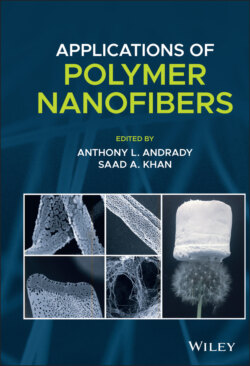Читать книгу Applications of Polymer Nanofibers - Группа авторов - Страница 26
1.6.3 Core–Shell Fibers 1.6.3.1 Coaxial Electrospinning
ОглавлениеHierarchically structured nanofibers, e.g. core–shell fibers have been of interest in a wide range of applications such as catalysis, drug delivery, and self‐healing materials (Li and Xia 2004; Crespy et al. 2012; Li et al. 2010; Moghe and Gupta 2008; Park and Braun 2010). One approach to making core–shell fibers has been coaxial electrospinning. In coaxial electrospinning, two polymer solutions are electrospun through a spinneret of two coaxial capillaries. Under steady operation, continuous, coaxial streams of both core and shell fluids are observed as they exit the nozzle. Following coaxial electrospinning, the core can be removed to achieve hollow fibers (Figure 1.5). Alternatively, the sheath can be removed to achieve smaller nanofibers than can be achieved with conventional electrospinning. Generally, the electrospinning solution selected for the sheath is electrospinnable. The core fluid may be electrospinnable or one that does not readily form fibers when electrospun alone. The shell fluid envelops the core fluid and prevents the core fluid from breaking up into droplets. Stabilization occurs due to viscoelasticity of the shell solution and reduced surface tension at the core–shell interface. Selecting a common solvent results in particularly low interfacial tension. Since electrospinning is a relatively fast process, the core and shell solutions may or may not be miscible; the two fluids do not mix significantly over the short duration of the electrospinning process. One important consideration is solubility of the polymer solutions, i.e. the polymers must not precipitate at the fluid interface (Moghe and Gupta 2008; Yu et al. 2004).
Analogous to conventional electrospinning, solution properties of both solutions and process parameters, e.g. applied electric field strength, flow rates, affect fiber quality. The flow rates of the core and shell solutions are of particular practical importance. If the flow rate of the core is too high, the core fluid breaks up into droplets. If the flow rate of the shell is too high, the spinning of the core is not continuous and the fibers form without a continuous thread of core material. Generally, having the core flow rate lower than the sheath flow rates promotes stable jetting of both fluids. Further, the ratio of the diameter of the core to the shell and core loading are dictated by the flow rates (Moghe and Gupta 2008; Yu et al. 2004).
Coaxial extrusion enables electrospinning of fluids that are difficult to process. Typically, the nonelectrospinnable polymer is the core with an electrospinnable shell solution (Yu et al. 2004). For example, to produce superhydrophobic materials, Teflon amorphous fluoropolymer (AF) has been processed using polyvinylidene fluoride (PVDF) as the shell polymer. Teflon AF coating has also been applied to PVDF fibers by coaxial electrospinning PVDF as the core and Teflon AF as the shell (Muthiah et al. 2010). Coaxial electrospinning is also useful in biomedical applications. For example, coaxial electrospinning has been used for encapsulating biological components, e.g. proteins and cells (Crespy et al. 2012). Coaxial electrospinning has also been extended to tricomponent systems with triaxial spinnerets (Yu et al. 2015; Han and Steckl 2013). Coaxial electrospinning allows for control over the location of the therapeutic agent (or any other desired core or shell material) through the use of multiple concentric spinnerets. Utilizing triaxial electrospinning, gradient release of a drug agent over the period of 20 hours or dual drug release (Yu et al. 2015). Use of more complex multichannel spinnerets and hierarchical multichannel nanotubes has been achieved by removing the inner fluid solution after spinning (Li et al. 2010). Advanced hierarchical structure with advanced spatial distribution of nanoparticles within nanofibers has also been achieved by combining triaxial electrospinning and block copolymer self‐assembly (Kalra et al. 2009). Although coaxial electrospinning allows tuning the internal hierarchical structure of multicomponent fibers, the main disadvantage is the complex setup required, i.e. multiple pumps, complex spinneret configurations. Scalability has also been a concern, although, free surface electrospinning of multiple fluid layers to achieve coaxial fibers has been reported (Forward et al. 2013).
